-
Car Reviews
- All reviews
- Midsize SUVs
- Small cars
- Utes
- Small SUVs
- Large SUVs
- Large cars
- Sports SUVs
- Sports cars
- Vans
Latest reviews
- Car News
-
Car Comparisons
Latest comparisons
- Chasing Deals
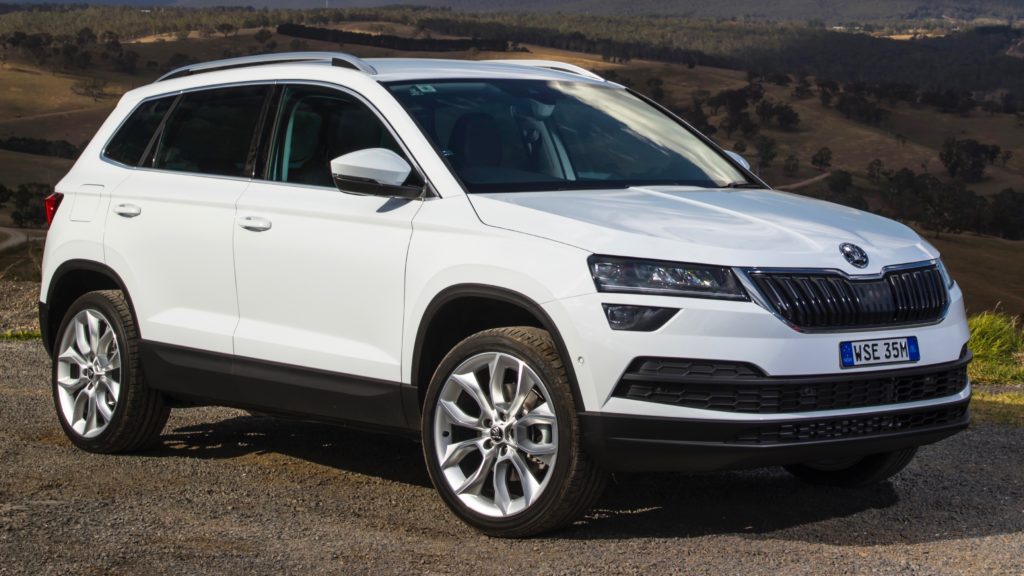
If you’re a practical person, Skodas are easy cars to like. Champions of pragmatic vehicles that generally also happen to be fun to drive, models like the Octavia wagon and hatch, and Kodiaq SUV, have impressed us in the past with their head-and-heart packages. Combine these attributes with good value for money and affordable servicing and the Skoda brand is something of an underrated all-rounder brand in Australia. Sales growth in the 11 years since the VW-owned, Czech-built brand launched in Australia has been slow – but steady – and this year the brand is aiming for the first 6,000-strong sales result. Part of the push is the arrival of the first medium-sized SUV from the brand – the 2018 Skoda Karoq.
Those familiar with Skoda will remember the Yeti SUV-cum-MPV launched in 2011. With funky, van-like styling and a near-unknown badge on the bonnet, the Yeti was cool – but slightly too weird – to find many homes here. But the size was right, and with the new Karoq, Skoda are trying again with a more conventional wagon-bodied SUV that shares most of its architecture with the Volkswagen Tiguan. The Karoq is Skoda’s second SUV, slotting beneath the seven-seat Kodiaq. In future, a small SUV will turn that duo into a trio. The Karoq will also be joined by performance-oriented versions by 2020.
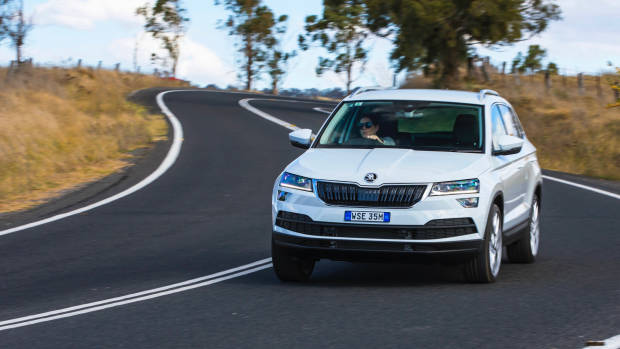
For now, though, the Karoq is a single-variant range, with the 110TSI model kicking things off at $29,990 plus on-roads. Under the bonnet is a turbocharged 1.5-litre four-cylinder engine from the Volkswagen Group stable that is new to Australia. With 110kW of power and 250Nm of torque, it sends its power to the front wheels through a six-speed manual or ($2,500-more expensive) seven-speed dual-clutch automatic. Next year, a more powerful turbo petrol grade with AWD and a standard DSG auto will arrive closer to $40,000.
For now, the Karoq competes with medium SUVs like the Mazda CX-5, Kia Sportage, Hyundai Tucson, Honda CR-V, Peugeot 3008 and the Karoq’s German cousin, the Volkswagen Tiguan. The Karoq is small-ish among this group, so its slight segment-shading means it’ll also be cross-shopped against SUVs from the segment below, so count the Nissan Qashqai, Toyota C-HR and Honda HR-V as Karoq rivals as well.
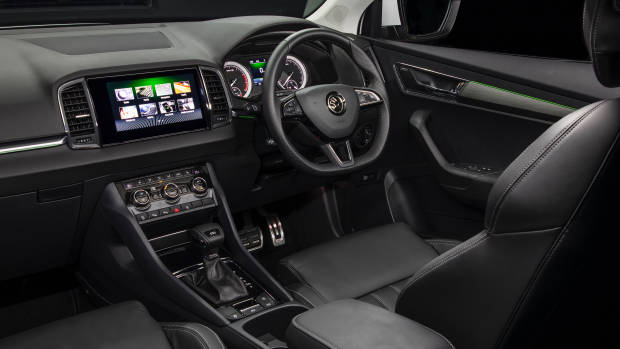
The Karoq makes a good case for itself out of the blocks with generous levels of standard equipment. Even at this sub-thirty grand price point, adaptive safety tech like forward-and-reverse AEB, adaptive cruise control and fatigue monitoring are included. In the cabin, you’ll find dual-zone climate control, an 8-inch touchscreen with Apple CarPlay and Android Auto, and configurable LED ambient lighting. Outside, every Australian Karoq includes desirable features like keyless entry (and start, unlike similarly-priced CX-5s), auto lights and wipers, and silver roof rails.
The decent value proposition continues after the Karoq has been brought home, too. The warranty and included roadside assist package is impressive, at five years and unlimited kilometres. Plus, the servicing is cheap – over three years or 45,000km, the Karoq costs $1,078 to service. Mazda’s CX-5 costs $1,268 over 40,000km.
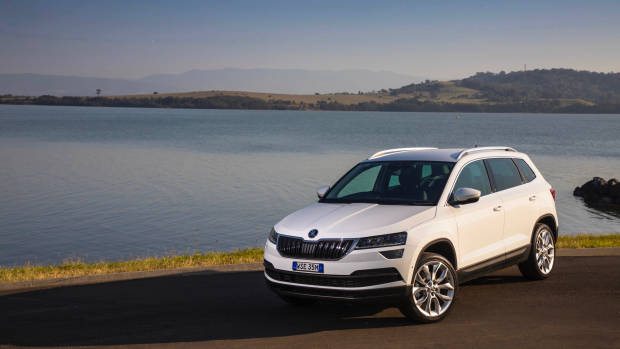
Standard kit is good, then, though a CX-5 does include different safety tech as standard at this price point, like lane keep assist, blind spot monitoring, and rear cross-traffic alert – though the Mazda doesn’t have adaptive cruise control like the Skoda. You can add those features to the Karoq for a little more money, though.
As usual with Skoda, options can be added in the form of packs, though frustratingly, the most desirable features are scattered through each of the packs meaning most people will end up ticking all three boxes, bringing the final price of a Karoq 110TSI to about $38,500.
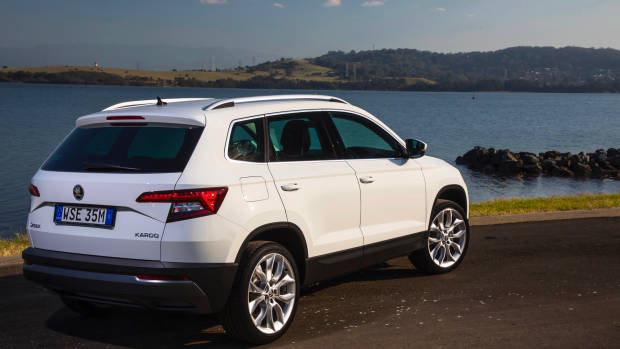
The $1,700 Travel Pack rounds out the safety tech with the aforementioned features, while also granting a 10-way electrically-adjustable driver’s seat with memory, heated front seats, and electric folding mirrors.
Meanwhile, the $3,600 Premium Pack adds luxe features like leather upholstery in black or beige, an electric tailgate, 18-inch wheels, LED headlights, stainless steel pedals, and front parking sensors.
Finally, the $3,200 Tech Pack adds a kick-to-open electric tailgate, a larger 9.2-inch touchscreen with navigation and DAB+ radio, a 10-speaker Canton stereo, wireless phone charging, drive modes, and automated parking.
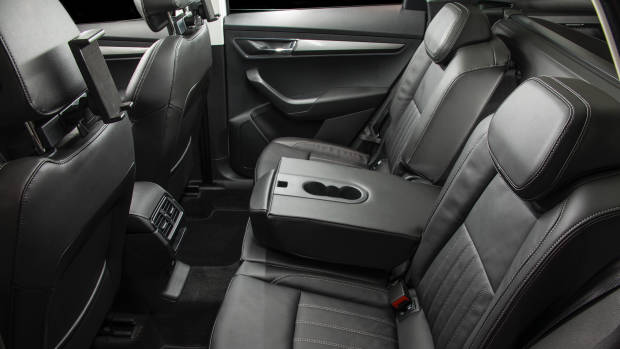
Further standalone options include premium paint ($700), a panoramic glass sunroof ($1,900), and 19-inch alloys ($700). A limited-time Launch Pack is also being offered for $8,900, which includes all aforementioned pack-options aside from the Canton stereo, plus three years’/45,000km free servicing (a value of $1,078).
On the road, the Karoq shines among medium SUVs. Most rivals use a thrashy, thirsty naturally aspirated petrol engine in the $30,000 car – here, the Karoq sets itself apart with a seriously refined 1.5-litre turbo petrol four-cylinder. Sure, the power and torque might be similar on paper to those naturally-aspirated Asian rivals, at 110kW/250Nm, but it’s where those figures are produced in the rev range that counts. The Skoda’s peak torque arrives at just 1,500rpm, or barely above idle – this is not an SUV that needs to be worked hard to make good progress. A Hyundai Tucson or Kia Sportage makes peak torque at 4,000rpm or more. Driveability and fuel economy are vastly superior in the Skoda.
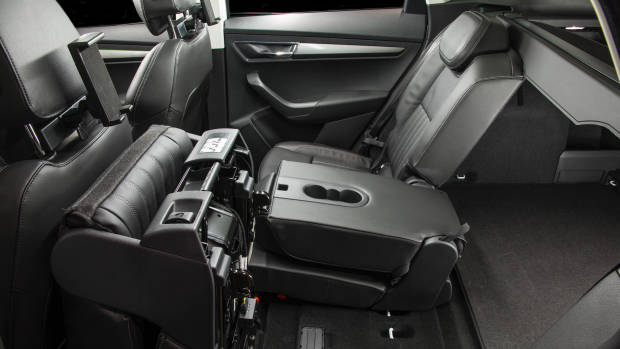
The 1.5TSI engine shuts down two cylinders in lighter driving, and it’s impressively efficient – Skoda claims 5.8L/100km combined for the manual and 5.9 for the DSG. This appears to be doable: we achieved south of 7L/100km. The Karoq is relatively quick: it hits 100km/h from rest in 8.4 seconds (manual) or 8.6 seconds (DSG) – an improvement over rival Koreans by almost two seconds.
The rest of the Karoq’s driving experience is pleasant, with an excellent ride quality even on 19-inch wheels; light but quick steering; and fun handling – the latter proving the spirit of the Yeti is still around. It’s also solid like a Tiguan while being softer over bumps, and with dartier handling thanks to a shorter wheelbase. Road noise is quiet enough – it’s not quite as hushed as the larger Kodiaq, but it’s much quieter than my Golf Mk 7.5.
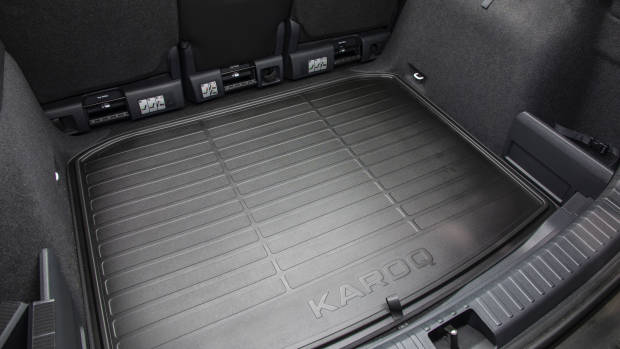
Measuring 4,382mm long, 1,841mm wide and 1,603mm wide, the Karoq straddles very relevant territory sizewise, between small SUVs and medium SUVs, but crucially, it provides more room than most midsize SUVs thanks to its efficient packaging. Here’s an example: the Mazda CX-5 measures 168mm longer than the Karoq, yet the smaller Czech provides appreciably more rear space, and the Skoda has a 37L-bigger boot with the seats pushed all the way back. Move the Karoq’s sliding rear seats forward, and its boot space grows to 588L – and you can actually remove the whole rear seat, evoking the spirit of the Yeti with 1810L in space – the biggest among all medium SUVs. With its seats folded, the Mazda manages only 1,342-litres.
Small families, take note: the Karoq’s back seats are its party piece, just like the Yeti. The rear bench is split into three, and each portion of the seat slides, reclines, tumbles, and can be totally removed to create a van-like space. Alternatively, the middle seat can be taken out and the outer seats moved in, creating a more spacious four-seater, but the car can also be driven in two-, three- and five-seat form depending owners needs. The rear cabin is spacious, with plentiful headroom and legroom for six-footers. The rear cabin is also well equipped with ISOFIX points on the outside seats, a 12V socket, rear air vents, door pockets, tablet holders on the back of the front seats and map pockets creating many spaces for passengers to place their items. Only cheap plastics on the doors jarr.
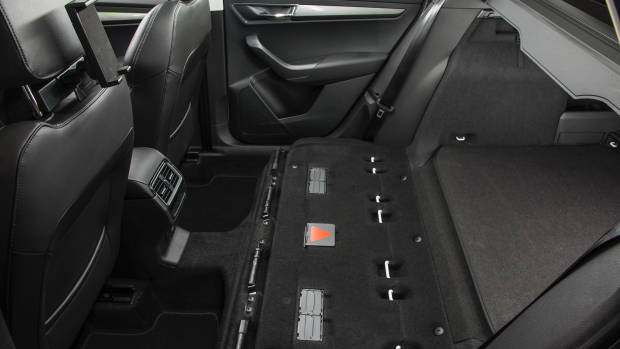
Up front, the dashboard design is conservative but functional, and good quality. The Volkswagen Group’s recent trend in slightly decreasing quality in cars like the Golf and Octavia is reversed here, as the Karoq gets richer soft plastics atop the dashboard and door tops. The lower dashboard is also soft, as it is in the Kodiaq though not the Tiguan or Golf – fabric or leather panels on the doors that would improve the look and feel further. Still, the Karoq’s cabin feels premium enough and while we can think of even higher quality cars – the 3008 and upper-spec CX-5s spring immediately to mind – they do cost significantly more to buy. The Karoq’s outward vision is excellent thanks to its thin pillars, and its seats are also comfortable, but Travel Pack is money well spent for the electric driver’s seat adjustment.
Being a Skoda, the Karoq’s cabin is very practical and filled with the brand’s ‘simply clever’ features with an umbrella under the front seat and a bin in the driver’s doorbin. The large door bins feature elastic bands to hold books and maps (though no flock lining, something that we evidently took for granted), the centre console tray is shallow but long and the centre box is huge, with an adjustable armrest and cupholders with raised grips to open bottles one handed whilst driving. The boot is also extremely practical, with a cargo cover that opens with the tailgate (Mazda was first with this), rails with adjustable shopping bag hooks, storage bins, nets with tie down points, a 12V socket and a rechargeable magnetic torch, a double-sided boot mat (one side is rubber and the other carpet) and a wide opening with a low load height to aid lifting heavy cargo.
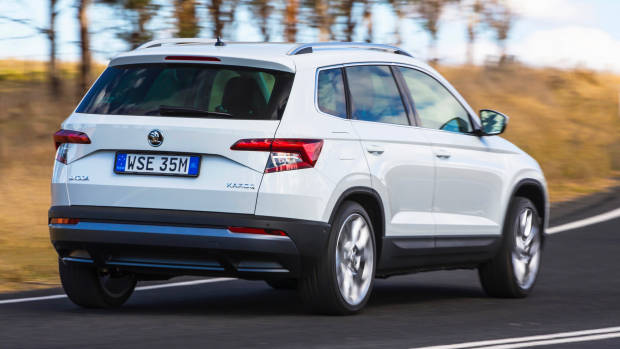
The Karoq is a much-needed product for Skoda in Australia, and thankfully for the brand, this is a very good effort. There really isn’t much this car does wrong. It’s spacious, well equipped, fun to drive, efficient, and did I mention spacious? The spirit of the Yeti is alive and well in the Karoq, though this time around, the more conventional, less quirky style and superior general public awareness of Skoda will definitely win it more friends. Could this be the car that catapults Skoda into higher sales in Australia? I hope so, but for now the Skoda Karoq is a very accomplished car that deserves to win many friends here.
Key specs (as tested)
About Chasing cars
Chasing Cars reviews are 100% independent.
Because we are powered by Budget Direct Insurance, we don’t receive advertising or sales revenue from car manufacturers.
We’re truly independent – giving you Australia’s best car reviews.
The estimate provided does not take into account your personal circumstances but is intended to give a general indication of the cost of insurance, in order to obtain a complete quote, please visit www.budgetdirect.com.au. Estimate includes 15%^ online discount.
^Conditions Apply
Budget Direct Insurance arranged by Auto & General Services Pty Ltd ACN 003 617 909(AGS) AFSL 241 411, for and on behalf of the insurer, Auto & General Insurance Company Limited(ABN 42 111 586 353, AFSL 285 571).Because we don’t know your financial needs, we can’t advise you if this insurance will suit you. You should consider your needs and the Product Disclosure Statement before making a decision to buy insurance. Terms and conditions apply.
Indicative quote based on assumptions including postcode , 40 year old male with no offences, licence suspensions or claims in the last 5 years, a NCD Rating 1 and no younger drivers listed. White car, driven up to 10,000kms a year, unfinanced, with no modifications, factory options and/or non-standard accessories, private use only and garaged at night.
^Online Discounts Terms & Conditions
1. Discounts apply to the premium paid for a new Budget Direct Gold Comprehensive Car Insurance, Third Party Property Only or Third Party Property, Fire & Theft Insurance policy initiated online on or after 29 March 2017. Discounts do not apply to optional Roadside Assistance.
2. Discounts do not apply to any renewal offer of insurance.
3. Discounts only apply to the insurance portion of the premium. Discounts are applied before government charges, taxes, levies and fees, including instalment processing fees (as applicable). The full extent of discounts may therefore be impacted.
4. We reserve the right to change the offer without notice.